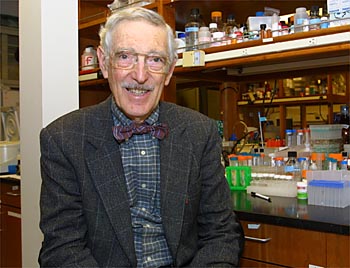
Authority or Science Methods?
Written 1996 by Steven LewisMost of the information I pass to my students they accept "on authority." Few bother to verify any of the material, and that's not necessarily because they do not have a scientific attitude. If a student were to attempt to verify a tenth of the material presented in a biology textbook they would be in introductory biology class for a lifetime performing experiments, dissecting cadavers, digging through stacks of original research papers .... Most of what a highly educated person knows about the world s/he knows from authority. No one has seen an electron. Our knowledge of its existence comes from the few people who have performed or studied the experiments. I assume the world is made up of atoms and electrons because most people who study the structure of the world in a rigorous way believe in them. I really have no other choice but to defer to the authorities.
My problem with "authority" is that most folks don't know who's a competent authority and who's a phony one. In my nutrition classes I get students who believe that Marilyn and Harvey Diamond or Susan Powter are nutrition authorities. I spend much of the semester explaining why they cannot be relied upon for nutrition information and how to determine who can be relied upon for competent nutrition information. I don't expect my students to replicate, or even study first-hand, the experimental foundations of modern nutrition, though!
 The issue for most of us is not whether we accept or reject the use of authority figures and institutions. We MUST use them. We have no choice. None of us can replicate all the relevant experiments or be an expert in all areas. Instead the issue is learning to differentiate between competent authority figures and those who are less than competent while remaining somewhat skeptical toward all. This includes learning to respect the views of those who follow science-mathematical methods. Here is where general semantics can be very useful. Part of what gs teaches us is that no one can have all the 'right' answers, and that even the best of scientists can be wrong. The result is that we should hold our authority figures to the test of other authority figures who have direct knowledge of the empirical foundations of a science. This is called "peer review."
The issue for most of us is not whether we accept or reject the use of authority figures and institutions. We MUST use them. We have no choice. None of us can replicate all the relevant experiments or be an expert in all areas. Instead the issue is learning to differentiate between competent authority figures and those who are less than competent while remaining somewhat skeptical toward all. This includes learning to respect the views of those who follow science-mathematical methods. Here is where general semantics can be very useful. Part of what gs teaches us is that no one can have all the 'right' answers, and that even the best of scientists can be wrong. The result is that we should hold our authority figures to the test of other authority figures who have direct knowledge of the empirical foundations of a science. This is called "peer review."
That is also why Korzybski felt it important to send proofs of Science and Sanity for review to many of the prominent scientists of his day.
We must also keep aware that as new data are discovered even a consensus among scientists may have to be changed. From 1923 to 1956 the consensus view among biologists was that the nuclei of human cells contained 48 chromosomes. The actual number, 46, did not displace the mistaken notion in textbooks until 1956. In the interval those who counted something other than 48 wrote off their count as an error or an abnormality of the cells used as the source of the chromosomes. For 3 decades biologists had seen what they believed, or else they refused to believe what they had seen.
Go to General Semantics Home Page ||| Go to Steven Lewis Home Page
